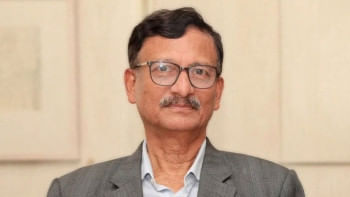Bangladesh-er-Swadhinota Sangrame Shilpishomaj By Biren Shome

Art of War
IT'S not often you come across artists writing on artists. Painters especially, tend to be retiring sorts who most of the time, would much rather have their brush rather than the pen do their talking for them, whether they would like to reminisce on some fond memory or relay some essential truth about the world. All art ultimately offers some interpretation of the world around them. But some truths, by virtue of their inviolate nature, can only be expressed through words.
That distinction in itself is enough to make the artist Biren Shome's book on Bangladeshi artists' contribution to the Liberation War of 1971 a bit of a rarity. What truly sets it apart is the rich trove it provides of the imagery associated with the war, as seen through the eyes of the nascent state's mostly young, ragtag band of artists, expressed in a variety of mediums. Many of the works, especially the posters, will be familiar to readers. Now you can put a name to them. So for example, whereas previously the famous print proclaiming the unity of all religions among the Bengali freedom-fighters has hung on many a university student's dorm wall, now we know that it was the work of artist Debdas Chakroborty. Similarly, it was good to put a name to the iconic image of the woman freedom fighter above a proclamation that Bengal's mothers and daughters were all freedom-fighters, a personal favourite. Pranesh Mondol did that one.
Biren Shome, who escaped to Kolkata in April 1971 fearing torture, as did many other artists, delves into the making of some of these seminal posters at length in this book, including Quamrul Hassan's famous, or infamous image of a collaborator with the equally famous proclamation - 'This monster needs to be murdered.'
The book titled 'Bangladesh-er Swadhinota Sangrame Shilpisomaj' (Artists in the Independence Struggle of Bangladesh) is a testimony to the historical role that artists played along with people of other walks of life. The 152-page book, divided into seven chapters, contains the diverse and decisive roles that the country's artists played in the liberation war, made richer for being recounted by someone who was an integral part of that community.
The book opens with an account of artists' engagement in national struggles from 1952 to 1971. With drawings, paintings and banners the book becomes more authentic. In another chapter titled '71-er Pothe Prantore', Biren Shome offers a glimpse into his personal involvement in the Mujibnagar Government. The chapter also showcases some of the suffering of the tortured masses in heartrending photographs. Other chapters of the book detail artists' roles in diverse fields like working in the information ministry of Mujibnagar government, producing posters, banners, drawings and paintings on pertinent themes. Particularly interesting is a chapter in which the book showcases prints of the paintings of 17 Bangladeshi painters who held group shows during the war in Kolkata, Delhi and Mumbai. The chapter offers a rare opportunity to see around 50 paintings on the liberation war. The book ends with 30 paintings by the author himself, all drawing inspiration from what remains the epochal event in Bangladesh's history.
The reviewer is Editor-in-Chief, UNB and Dhaka Courier


 For all latest news, follow The Daily Star's Google News channel.
For all latest news, follow The Daily Star's Google News channel. 



Comments